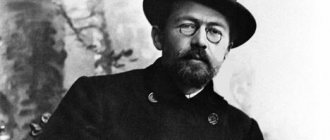- Essays
- On literature
- Other
- Analysis of the novel Notre-Dame de Paris by Hugo
The genre focus of the work is a combination of historical epic novel, psychological prose and romantic drama, the key theme of which is the depiction of private human passions against the backdrop of historical events.
The compositional structure of the novel is circular, expressed in the description at the beginning of the work of the fatal word inscribed on the walls of the cathedral, transporting the reader to the events of distant years, and in the finale there are images of two skeletons intertwined in an embrace, symbolizing the main characters of the novel in the person of a hunchback and a gypsy, history which have been erased into dust by time.
The main characters of the novel are Esmeralda, presented as a young, attractive gypsy, a serene street child, Quasimodo, depicted as a hunchback serving as a bell ringer in the Cathedral, Claude Frollo, who is a priest, and Phoebus de Chateaupert, described as a military officer.
A distinctive feature of the novel is the image of the Cathedral, which seems to be a genuine character in the work, connecting all the characters with each other. The cathedral is the main place of plot events, a silent witness to tragedies, love relationships, the life existence and death of the main characters, a symbol of immobility and steadfastness in fleeting human life.
The storyline of the novel revolves around the love of the male part of the characters in the person of Quasimodo, Frollo's father, Phoebus, as well as the minor hero Gringoire, a local poet, with Esmeralda, while each hero's love has distinctive features.
Love for a gypsy ends in tragedy. Phoebus, who feels only physical attraction to the girl, and also has his own bride, invites Esmeralda on a date, where the priest also goes, in a fit of jealousy inflicting a wound on the officer. Esmeralda is arrested on charges of murdering Phoebus, as well as witchcraft and prostitution, and is sentenced to death by hanging. However, the girl manages to escape with the help of the hunchback Quasimodo. But after some time the authorities carry out the sentence, and the girl dies. Quasimodo, avenging the death of his beloved woman, throws the hated father Frollo off the walls of the Cathedral.
The meaning of the novel lies in the frequent discrepancy between a person’s external appearance and his inner spiritual world, which is capable of strong feelings, as well as self-sacrifice.
Esmeralda's failed kidnapping
At this moment, attention is drawn to the bell ringer Quasimodo, known for his ugliness. He is dressed, as he should be, in a robe, and then taken away to walk with him through the streets. After this, Gringoire hopes to continue the play, but someone’s cry that Esmeralda is dancing in the square leads the audience in that direction. Esmeralda is a gypsy who entertains the gathered crowd with her goat. After Quasimodo appears in the square, the girl is almost kidnapped. Gringoire, who heard her screams, immediately calls for help. Phoebe de Chateaupert, captain, becomes Esmeralda's savior.
History of creation, genre, direction of the novel
Note 1
Notre Dame is the first historical novel written in French.
The idea for this work originated with V. Hugo back in the 1820s. The novel was published in March 1831.
The work was a response to the spiritual crisis that France was experiencing at the beginning of the 19th century. French society, after a series of bloody wars and several revolutions, became increasingly divided. People became indifferent to things that did not provide any benefit. Notre Dame Cathedral, which had been in a deplorable state since the fall of the empire and was under threat of demolition, in the eyes of the writer became the personification of the lost French people.
Are you an expert in this subject area? We invite you to become the author of the Directory Working Conditions
Hugo, trying not only to draw attention to the problem of the cathedral, but also to awaken in people national pride and interest in history, began writing a novel in 1828.
Note 2
It is noteworthy that after the publication of the work, a movement arose in France, and then throughout Europe, advocating the preservation of architectural monuments.
Hugo's novel combines several literary trends:
- Sentimentalism;
- Romanticism;
- Realism.
From sentimentalism in the novel - an idealized image of the heroine. From romanticism - titanic images of the main characters, rising above the rest of the vicious society due to their moral qualities. Realism brought a dose of ambiguity, as well as deeply developed images of characters that combine both positive and negative traits. In addition, the naturalism and harshness of the world depicted in the novel are characteristic of realism.
In terms of genre, Notre Dame is a historical novel. The narrative covers a long period of time and includes a large number of characters and significant events.
Finished works on a similar topic
Course work “Notre Dame Cathedral” by V. Hugo 480 ₽ Essay “Notre Dame Cathedral” by V. Hugo 270 ₽ Test “Notre Dame Cathedral” by V. Hugo 240 ₽
Receive completed work or specialist advice on your educational project Find out the cost
The court verdict and the rescue of Esmeralda
Gringoire, worried about Esmeralda, learns a month later that she is to be tried at the Palace of Justice. Since the girl is innocent, she denies everything. However, after torture, Esmeralda still admits the crimes attributed to her: the murder of de Chateaupert, prostitution and witchcraft. She is sentenced to repentance, after which she is to be hanged near Notre Dame Cathedral. Claude Frollo, in love with her, offers to escape to Esmeralda, but the girl rejects his offer. The priest responds by stating that Phoebus is alive. This is confirmed on the day of the execution, when Esmeralda sees her lover in one of the windows. Quasimodo picks up the gypsy who has fallen unconscious. He takes her hastily to the Cathedral, thereby providing refuge for the girl.
Who is Quasimodo?
Quasimodo is a hunchback, picked up in infancy by the minister of Notre Dame Cathedral. The servant's good deed was rewarded with the devotion of the child, who remained to live in the cathedral and began to perform the duties of a bell ringer.
But people mocked the ugly man, were afraid of him and even shied away. Even in the photographs brought to life by artists, Quasimodo looks frightening. This made Quasimodo a withdrawn, angry and even cruel person. It seemed that he was capable of warm feelings, but at one moment he met the beautiful gypsy dancer Esmeralda.
Plot of the novel
One evening, dancer Esmeralda is attacked by two unknown men. One of them manages to be detained, and he turns out to be the hunchback Quasimodo. As punishment, he is chained to a stake and beaten with a whip. The hunchback asks for a sip of water, but no one responds to his request, the crowd laughs at the ugly bell-ringer and mocks him. And only one person approaches Quasimodo with a glass of water. This person turns out to be the victim herself - Esmeralda. A generous act moves the embittered hunchback to tears.
The second criminal who remained uncaught is the minister of Notre Dame Cathedral Frollo. He is attracted to a beautiful gypsy, but she does not reciprocate because she is in love with the capital de Chateaupert. She is about to reveal her feelings to him, but Frollo, who is pursuing her, gets ahead of her, trying to kill the captain.
Esmeralda is accused of the assassination attempt on de Chateaupert on the sole grounds that she is a gypsy, and therefore a witch. The surviving captain makes no attempt to help Esmeralda, and Frollo comes up with an ominous plan: to appear to the prisoner and offer her to become his wife in exchange for freedom. The beautiful dancer categorically refuses the offer, and the clergyman decides that the death penalty for Esmeralda is the best way to get rid of her own love experiences.
Esmeralda and Frollo
Claude Frollo and Esmeralda act as antagonists. Esmeralda is bright and pure, despite the fact that she is a street dancer. Uneducated and raised by gypsies and vagabonds. At the same time, she is open, all her feelings are visible, maybe that’s why they are so sincere and crystalline. Esmeralda does not hide how she feels. Selfless love for the handsome Phoebus, sympathy for Quasimodo and burning disgust and fear of the abbot - all this lies on the surface and is visible to the naked eye.
Claude Frollo is forced to hide his identity from an early age. The role of a diligent student and ascetic crumbles in the face of a burning, all-consuming passion. This is not love (like Quasimodo, who loves a young gypsy with all his open, wounded heart), this is a blinding passion, a desire to own a girl like a precious thing, to subjugate her to himself. He is not capable of self-sacrifice; rather, he will sacrifice the lives of others for the sake of his interests and needs. Love cannot find a place in his frozen heart; it only burns his body and mind with fire.
Final Events
Hugo's book “Notre Dame de Paris” is already approaching its finale. The author transfers the action to Roland's Tower, where Paquette Chant-Fleury, who hates Esmeralda, lives. Once upon a time, her daughter was taken away from her. However, it suddenly turns out that Esmeralda is her missing girl. The mother fails to save the gypsy from execution. She falls dead when they try to stop her from being taken away. The work created by Victor Hugo (“Notre Dame de Paris”) ends with the following events: Esmeralda is executed, and then Quasimodo pushes Claude into a cliff. Thus, everyone whom the unfortunate hunchback loved is dead.
So, we have described the main events that are depicted in the work “Notre Dame Cathedral”. Its analysis, presented below, will introduce you closer to the main characters of this novel.
Meeting with Chateaupert, attempted murder by Claude Frollo
After some time, Esmeralda is invited to the house of Phoebus de Chateaupert. Here he wants to have fun with his bride and her friends. When Esmeralda appears, her beauty amazes everyone, as Victor Hugo (Notre Dame de Paris) notes. When this gypsy’s goat puts together the word “Phoebus” from letters, the bride faints. The gypsy is in love with the captain and is even ready to stop searching for her parents. During a meeting with Chateaupert, Esmeralda is confronted by a priest with a dagger who hates her. The girl loses consciousness. When she comes to her senses, she finds out that she allegedly killed Chateaupere.
Claude Frollo
This is the archdeacon serving at Notre Dame Cathedral. He is wise in various sciences. This is a rational and proud person who is overwhelmed by passion for Esmeralda. Frollo pursues the girl relentlessly and is ready to commit any crime in order to get her. He instructs Quasimodo, his pupil, to kidnap the gypsy, and also tries to kill Captain de Chateaupert, her beloved. The girl is accused of attempted murder and sentenced to death. Then Frollo invites her to flee in exchange for satisfying his fatal passion. When Esmeralda refuses, he incites the ragamuffins of Paris to take the Cathedral in which the girl has taken refuge by storm. Claude, in the midst of this massacre, kidnaps Esmeralda. The girl again rejects his love. Enraged by the death of his younger brother, who took part in the attack, Frollo gives his beloved to death.
Being the main driver of the action of the work, Claude himself is a rather traditional figure. He embodies a type of demonic churchman who is obsessed with passion for a woman. This type was inherited from the Gothic novel, which depicts similar protagonists. The image of Frollo, on the other hand, resembles Doctor Faustus in his learning and dissatisfaction with it. This side of the character connects the archdeacon with the line of Hugo’s novel.






